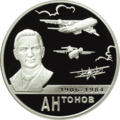Oleg Antonov (aircraft designer)
Oleg Antonov | |
|---|---|
Олег Антонов | |
USSR (now Kyiv, Ukraine) | |
| Citizenship | Russian Empire → Russian SFSR → Soviet Union |
| Alma mater | Leningrad Polytechnic Institute (1930) |
| Occupations | |
| Years active | 1924–1984 |
| Known for | Antonov aircraft |
| Title | |
| Spouse | Stalin Prize (1952) |
| Signature | |
 | |
Oleg Konstantinovich Antonov (
for both civilian and military use.Early life
Antonov was born on 7 February 1906 in Troitsy, Moscow Governorate, Russian Empire (now Podolsky District of the Moscow Oblast), Russian Empire to a family of Russian ethnicity.[1] In 1912, the Antonovs moved to Saratov, where he attended the non-classical secondary school (now gymnasium №1) and secondary school (now school №23). From an early age, Antonov was fascinated with aviation and spent much of his spare time at the local airfield.
Early engineering career
At the age of 17, Antonov founded the "Amateur Aviation Club" and later joined the "Organization of Friends of the Air Force". Later he designed the OKA-1 "Pigeon", a glider that was entered in a competition in Moscow where he won the first prize, a flight on a Junkers 12 aircraft.[2][3]
In 1930, Antonov graduated from the
In 1938, after an incident when an instructor defected to the West using a glider, the Soviet government reversed its decision regarding glider training, banned the sport of gliding and shut down the Moscow Glider Factory.
Professional designer career and World War II
Following the closure of the glider factory in 1938, he unsuccessfully applied to enter Zhukovsky Air Academy the same year. He then in 1940 joined Yakovlev's Sportsplane Factory and there, after receiving two aircraft from Germany in June 1940, he was assigned to prepare the German Fi 156 Storch for production in Kaunas. He was also tasked with designing an ambulance version of the aircraft.[4][5]
Antonov was appointed chief designer for the Yakovlev Design Bureau. In 1940 a new aircraft design bureau under his own management was established in Leningrad. The German invasion resulted in the closure of the plant and he was reassigned to work on the A-7 glider. The factory was later reorganised to produce A-7s.[2]
During World War II, the A-7 was used for airbridge supply of the Soviet partisans behind the front lines. Antonov also worked on the Antonov A-40 biplane glider that was designed to airlift tanks, but this project proved unsuccessful. In total during the war around 450 A-7s were produced. In 1943, Antonov returned to the Yakovlev design bureau to fill a vacancy as Yakovlev's first deputy designer. He was put in charge of Yak-3 and also of production at Novosibirsk. Much of his time and energy was devoted to the improvement of the Yak series, one of the most mass-produced fighter aircraft types of World War II.[2]
Postwar career and establishment of the Antonov Design Bureau

After the war, Antonov requested that Yakovlev let him work independently, heading Yakovlev's subsidiary design office at the aircraft manufacturing factory at Novosibirsk. On 31 May 1946, Antonov was appointed head of the newly redesignated facility (subsequently known as the
The first of the Antonov Bureau's designs was the SKh-1 (Sel′sko Khozyaystvennyi- pervoy - agricultural-first one) agricultural aircraft, later redesignated An-2, designed to meet a 1947 Soviet requirement for a replacement for the Polikarpov Po-2 which was used in large numbers as both an agricultural aircraft and a utility aircraft. Antonov designed a large single-bay biplane of all-metal construction, with an enclosed cockpit and a cabin accommodating 12 passengers.
A series of significant transports followed under Oleg Antonov's direction. Antonov aircraft (design office prefix An-) range from a rugged An-2 (which itself is comparatively large for a biplane) through the
In 1965 Antonov signed a petition in defense of
Family
Antonov was married three times (to Elena Kochetkova, Yelyzaveta Shahatuni, and Elvira Antonova) and was the father of four children (Rolan, Anna, Elena, and Andrei).[9]
Death
Oleg Antonov died 4 April 1984 in
Honorary titles, awards and legacy


During his lifetime, Antonov was recognized as a
Among numerous awards, Antonov received the
Antonov was decorated with three
A street in
In 1999, Antonov was inducted into the International Air & Space Hall of Fame at the San Diego Air & Space Museum.[10]
A coin was minted of copper nickel alloy in 2006 by the
External links
Gallery
-
Antonov An-124
-
Antonov An-225
References
Notes
- ^ "Антонов Олег Константинович". Archived from the original on 29 September 2020. Retrieved 25 May 2016.
- ^ a b c d e "Biography of Oleg K. Antonov."Archived 22 May 2009 at the Wayback Machine People’s Museum Press Service of Antonov ASTC, Council of Antonov ASTC, © 2005. Retrieved: 25 May 2009.
- ^ Soviet Life. Embassy of the Union of the Soviet Socialist Republics in the USA. 1980.
- ISBN 978-0-7146-4784-5.
- ^ Dancey, Peter G. (22 April 2017). Soviet Aircraft Industry. Fonthill Media. Archived from the original on 19 May 2023. Retrieved 31 August 2023.
- ISBN 9781780229287. Archivedfrom the original on 4 April 2023. Retrieved 9 June 2021.
- ^ "AS 922. Appeal in Defense of Arrested Ukrainian Intellectuals". Blinken Open Society Archives. Archived from the original on 14 July 2021. Retrieved 14 July 2021.
- Zn.ua (in Ukrainian). Archivedfrom the original on 3 January 2023. Retrieved 3 January 2023.
- ^ (in Ukrainian) "The police asked Antonov not to go in shorts on the bazaar" Archived 8 March 2018 at the Wayback Machine, Segodnya (7 February 2008)
- ISBN 978-1-57864-397-4.
Bibliography
- Anisenko, Viktor G. O.K. Antonov: Versatility of Talent. Aero Hobby PC.
- Gordon, Yefim. Antonov An-2: Annushka, Maid of All Work-Red Star Volume 15. Hersham, Surrey, UK: Midland, 2004. ISBN 978-1-85780-162-0.








